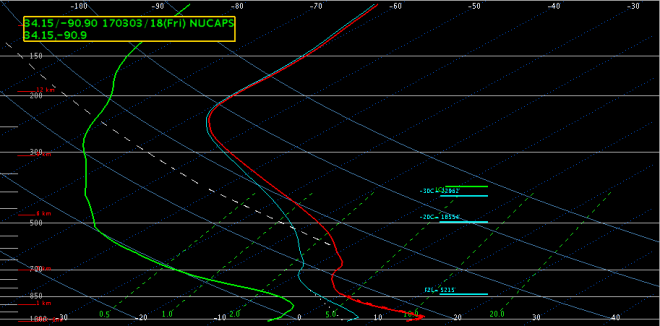SPoRT has been part of a multi-organizational collaboration within the JPSS Sounding Initiative to develop products from Hyperspectral Infrared Sounders and assess the utility of the new observations in the operational environment. Many of the products and capabilities start out as a “proof of concept” and are then introduced to end users to incorporate end user feedback into the design and implementation process, one example of this is Gridded NUCAPS. The team has focused on satellite soundings processed through the NOAA Unique Combined Atmospheric Processing System (NUCAPS) which is the NOAA operational satellite sounding retrieval algorithm for hyperspectral infrared sounders on S-NPP and NOAA-20. Currently NOAA-20 NUCAPS Soundings and Gridded Products are available to all National Weather Forecast Offices. A recent article “Adapting Satellite Soundings for Operational Forecasting within the Hazardous Weather Testbed” highlights the applied research, assessment of satellite soundings in a quasi-operational setting, and the role of end-user feedback in adapting products/capabilities to meet end users’ needs. The team comprised of algorithm developers, product developers, and end users has found ways to interact, translate science to operations/operations back to science, leveraging the cross-benefit of science and applications to guide applied research to improve satellite sounding algorithms and products.
The success of NUCAPS for the Cold Air Aloft aviation hazard and diagnosing the pre-convective environment along with the accessibility of NUCAPS products to end users has led to applied research to assess the utility of products for additional applications (Berndt et al. 2020). NASA’s 2017 Decadal Survey points out “The final missing piece of applications research in the agencies is the very initial phase of creating applications—supporting studies that have an idea about how an application might work, and then attempting to create a community for it, and demonstrate its utility”. There are complex barriers that exist when identifying end users and transitioning relevant data to meet their needs. As pointed out by NASA’s 2017 Decadal Survey “… the applications field is becoming associated with a science of its own…” Recently, SPoRT has investigated the utility of NUCAPS products for fire weather applications as a “proof of concept”. As SPoRT engages with users on application of NUCAPS observations, a new interactive training was developed to communicate the value and utility of these data. SPoRT has found that creating short, focused, applications-based training can remove some barriers to end users integrating new data and capabilities in operations. Last SPoRT has created a NUCAPS webpage where scientist and users can find information relevant to NUCAPS products, resources such as training, blogs, peer-reviewed literature, and data access.

New Interactive training on application of NUCAPS products to assess fire weather conditions –> Go to training

NUCAPS resource webpage for scientists and end users –> Go to webpage



































You must be logged in to post a comment.